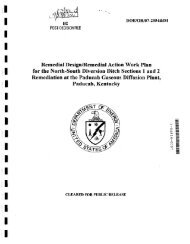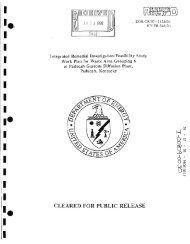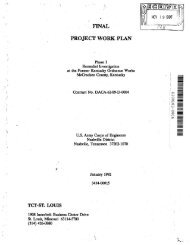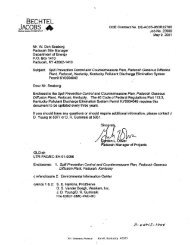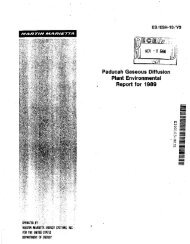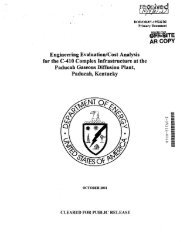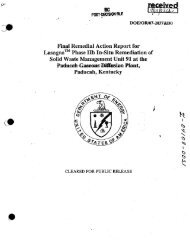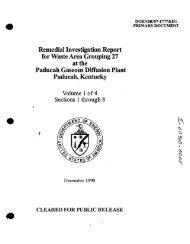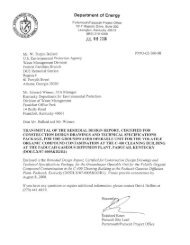1 - paducah environmental information center
1 - paducah environmental information center
1 - paducah environmental information center
Create successful ePaper yourself
Turn your PDF publications into a flip-book with our unique Google optimized e-Paper software.
Paducah Site<br />
Sediment<br />
Sediment is an important constituent of the<br />
aquatic environment. If a pollutant is a<br />
suspended solid or is attached to suspended<br />
sediment; it can settle to the bottom (thus<br />
creating the need for sediment sampling), be<br />
taken up by certain organisms, or become<br />
attached to plant surfaces. Pollutants in solution<br />
can adsorb on suspended organic and inorganic<br />
solids or be assimilated by plants and animals.<br />
Suspended solids, dead biota, and excreta settle<br />
to the bottom and become part of the organic<br />
substrata that support the bottom-dwelling<br />
community of organisms.<br />
Sediments play a significant role in aquatic<br />
ecology by serving as a repository for<br />
radioactive or chemical substances that pass via<br />
bottom-feeding biota to the higher trophic<br />
levels. Figure 5.2 shows possible exposure<br />
routes of trace metals (including uranium) in an<br />
aquatic ecosystem.<br />
Sediment Surveillance Program<br />
I.<br />
IWlARDOO<br />
o 310.1<br />
I<br />
SEDIMENTSAMPUNG<br />
o 2 MILES POINT (SS)<br />
Figure 5.3 Routine sediment sampling<br />
locations.<br />
Sediment samples were taken from six locations<br />
(Figure 5.3). Table 5.3 shows the radiological<br />
analytical parameters.<br />
As a result of DOE's retaining responsibility<br />
for historic <strong>environmental</strong> issues and problems,<br />
ditch sediments are sampled annually through a<br />
radiological <strong>environmental</strong> surveillance program.<br />
Water Dissolved Solids<br />
a 1 ~i g<br />
..<br />
!l '" .5<br />
If<br />
~<br />
g~J<br />
.l!<br />
'"<br />
'"<br />
.~<br />
.2<br />
I<br />
H~ ~ ,<br />
!!5<br />
J ..<br />
j ..<br />
..§ . "<br />
1<br />
... s .g !<br />
=<br />
.~<br />
l! 8<br />
]<br />
"? i ." ~<br />
.. l:- f<br />
Colloidal Suspended ~<br />
Suspension Sediments ·8<br />
= c ~<br />
~<br />
j<br />
=<br />
~<br />
~ Jl<br />
'" ]<br />
.l!<br />
l<br />
~<br />
Bottom Sediment<br />
Figure 5.2 Routes of trace metals In an aquatic<br />
ecosystem (Jinks and Eisenbud 1972).<br />
Sediment Surveillance Results<br />
Table 5.4 shows the radionuclide sediment<br />
sampling results for 1999. Locations SS 1, SS 2,<br />
and SS 27 are downstream of plant effluents.<br />
Locations SS 20, SS 21, and SS 28 are considered<br />
reference, or background sites, and can be used<br />
to compare with downstream data. SS 20 and SS<br />
21 are on different creeks upstream of the plant<br />
Table 5.3 Radiological Sampling<br />
Parameters for Sediment Surveillance at<br />
the Paducah Site for 1999<br />
Station<br />
SS 1, SS 2, SS 20,<br />
SS 21, SS 27, SS28<br />
Parameter<br />
m cs , 4°K, 237Np, 239 pU ,<br />
99 Tc , 23~h, total U, 234V,<br />
235<br />
U , 2J8U, 60Co, l.IAm,<br />
alpha activity, beta<br />
activity<br />
5-4<br />
Radiological Environmental Surveillance



